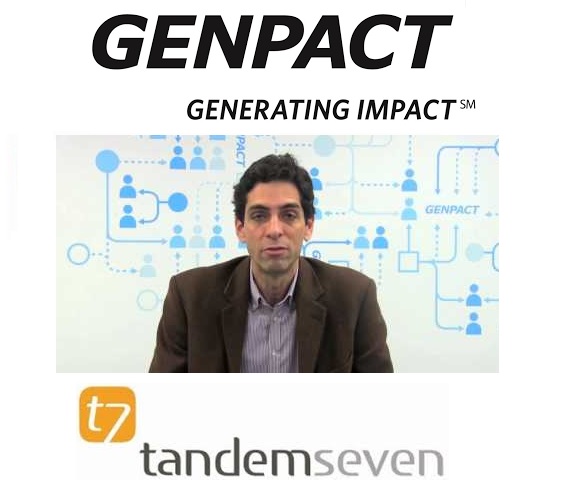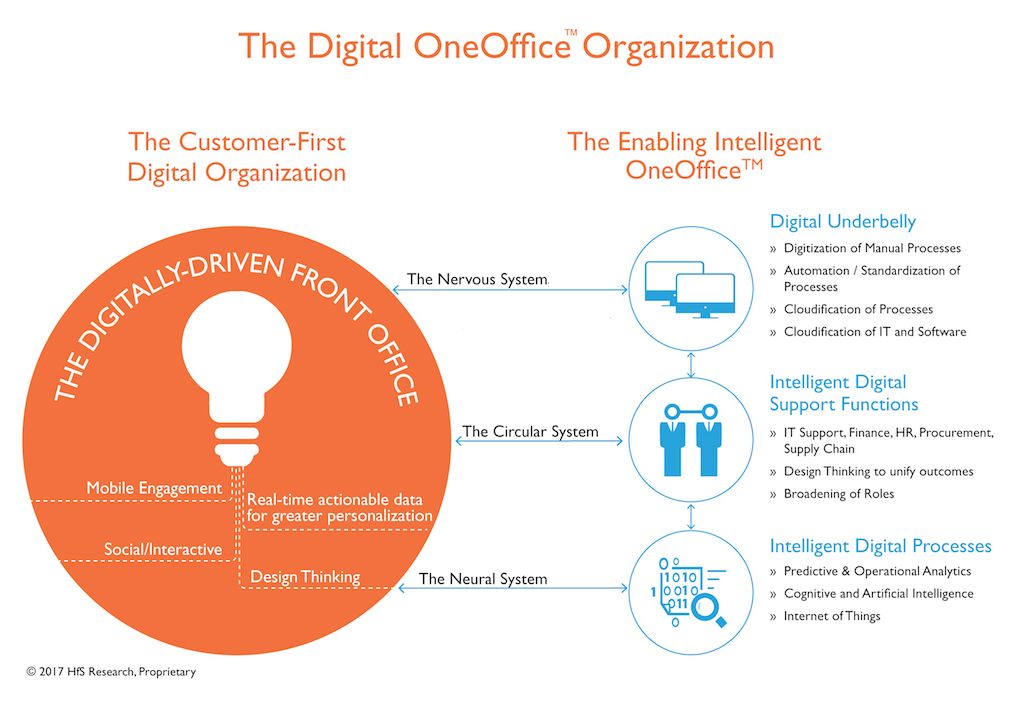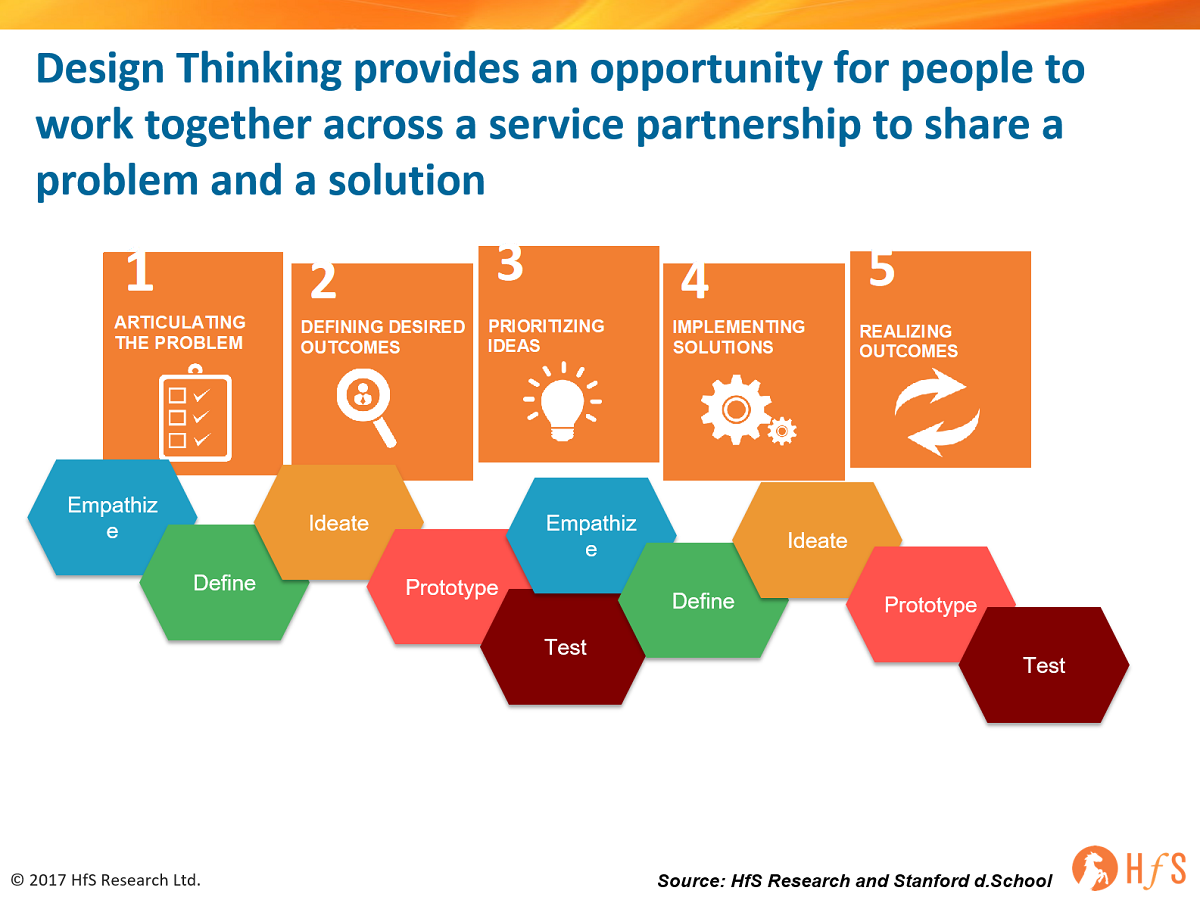
“You guys really should evolve your lean capabilities into Design Thinking with your clients” was my conversation with Genpact’s innovation lead, Gianni Giacomelli (pictured), a year ago. “You should also do that with your research clients” was Gianni’s response. Exactly a year later, we open our Research ThinkTank in Cambridge England to perform said exercises with our clients, and Genpact announces the acquisition of Design Thinking specialist TandemSeven in Cambridge Massachussets.
Why is Design Thinking becoming so relevant to the middle-back office operations?
We see the emergence of Design Thinking as critical to help enterprises collapse these barriers between their front, middle and back offices – one of the core fundaments of achieving a true OneOffice framework. You really can’t be a digital organization if your operations are not supporting the front office in realtime, being able to respond to customer needs as and when they happen:

Design Thinking offers an approach for a diverse group of people to work together to identify and articulate a common problem, brainstorm ideas for addressing it, quickly prototype/wireframe/storyboard and test it, and continue to iterate on the idea as it takes shape into a proposed solution. A Design Thinking led approach to designing a Digital OneOffice framework moves the focus of the operations executive and service provider partner away from the process itself, and the internal, “what’s wrong inside of what we do” to “what do we actually want to achieve” (the business outcome), and what do we want people to feel and do naturally that will lead to further engagement and new—and different—results.
At HfS, we are finding that Design Thinking is actually changing the way many clients and service providers work, that there is a real complement between designers, consultants, engineers, and service delivery as organizations seek to bring the front, middle and back offices closer together to achieve common outcomes. Moreover, it’s vital that Design Thinking is firmly embedded as the method for ongoing engagement across all organizational stakeholders, as outcomes constantly evolve as markets evolve and business needs change.
Incorporating Design Thinking Into business context for shared services and outsourcing
You can use Design Thinking to understand what’s really causing problems or issues or expenses, by better understanding what people are actually doing –or not—and feeling. What is their experience? And then working through ideas that may revise, or replace, or eliminate process; that may change what people are doing and how; and could use current technology better, or new technology. As one shared services executive told us, “we already know how to make something efficient [with Lean Six Sigma] and we required a new way of thinking in some specific areas.” Along these lines, we are not anticipating an end or replacement to Lean Six Sigma or “operational excellence” but adding a way of stepping outside the process to identify trouble spots and new solutions.–or not—and feeling. What is their experience? And then working through ideas that may revise, or replace, or eliminate process; that may change what people are doing and how; and could use current technology better, or new technology.
With Design Thinking you focus on understanding who is involved in whatever process or problem you are looking to address, and what are their expectations and needs (the “human” side)? And what is the industry and corporate context, the business outcomes to impact (the “business” side)? And what are the technology enablers? Then bringing it all together in a solution through a series of prototypes and tests. Sometimes the solution is a quick fix, like changing the day of the week or where a request from a consumer is directed in a system; and sometimes it will help you identify a new way of working or a new service or solution.

When HfS published the Design Thinking in the As-a-Service Economy Blueprint earlier this year, we looked at how service providers are working with clients to integrate person-centered design and experience in business operations through the use of design thinking expertise, methods, and tools. Genpact and clients shared with us how it’s bringing design thinking into the Lean Digital framework to combine with its heritage strengths in analytics and use of agile methods and artificial intelligence platform Rage Frameworks for innovation. However, Genpact lacked relevant design thinking tools and IP, breadth in capability, and experience. Until now, it relied primarily on partnerships with design firms and leveraging its delivery centers for developing prototypes.
Bottom-Line: TandemSeven’s capabilities will help Genpact break down barriers holding back rigid “process first” operational structures
In short, TandemSeven adds two key components to Genpact:
– Dynamic journey mapping tool and integrated principles: Challenges that we’ve heard with design-thinking innovation for services and operations include: moving from design to action, engaging stakeholders who were not in the original design activity, and measuring impact. TandemSeven’s UX360 is cloud-based journey mapping software that includes a set of templates to lay a foundation for custom journeys that can then be customized as needed and benchmarked for progress. Users can integrate with analytics and lifecycle management tools. It can also be shared for collaborative efforts, and we expect it can be used across organizations as individuals and teams enter and exit projects, keeping everyone on the same journey to the targeted outcome. In addition, TandemSeven emphasizes the need to tailor information in the map to business stakeholders and identify qualitative and quantitative metrics, such as customer satisfaction surveys and web analytics, and key performance indicators. Genpact will need to figure out how to integrate UX360 into its Lean Digital method and toolset and the implications of licensing and sharing to scale it over time. However, it does fill a critical gap here and provide something unique for the service provider.
– Design Thinking expertise: While Genpact launched a credible training effort internally over the past two years on Design Thinking methods and principles, it lacked depth of expertise and experience. TandemSeven adds designers, consultants, and technologists and a client list that ranges from the Fortune 500 to startups and includes public companies and private organizations, e.g, Humana, McDonald’s, Royal Bank of Canada, Pfizer, Southwest Airlines, and University of San Francisco. It is North America centric so it does leave much of the world “uncovered” in terms of local offices and expertise, but can tap into and partner with Genpact’s broad global delivery network.
Genpact is clear in its intent to integrate Design Thinking into its Lean Digital way of working, and orient itself 100% on “customer first” not “process first”. The UX360 tool and team of professionals it is bringing in through this acquisition is intended to help orient, design, and realize this vision by being an integral part of what Genpact has in place with its strengths in targeted industries (e.g., banking), process, analytics, and technology. This acquisition positions Genpact to work with clients in a more integrated fashion over time – with an human-centered reimagination of how to better use talent and technology together in “OneOffice” to create experiences and impact business outcomes.
Click here to read HfS analyst Barbra McGann’s POV on the acquisition
Posted in : Design Thinking





